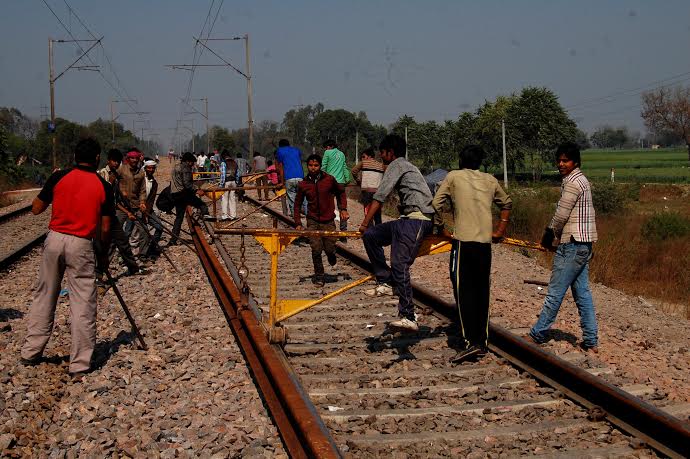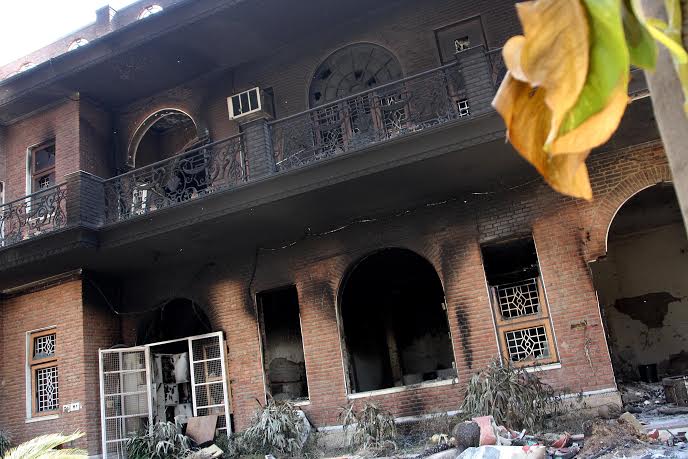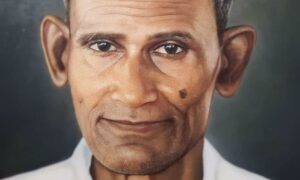Haryana riots: things you may want to know!


A view of the gutted building of a factory at in Rohtak on Tuesday. February 23, 2016: Photo by Manoj Dhaka
Chandigarh: The mighty Jats of India’s northern Haryana state hit the streets to be included amongst Other Backward Classes (OBCs) on February 13 in Hisar district.

A goods train which was set on fire by agitating youths near Sonepat on Monday. February 23: Photo by Manoj Dhaka

Railway workers repair a track damaged during the blockade near Sonepat on Tuesday. February 23: Photo by Manoj Dhaka

The paramilitary forces make the way for chief minister ML Khattar to board his car after he was gheraoed by the traders in canal rest house in Rohtak on Tuesday. Photo by Manoj Dhaka
While violence marked the nine-day agitation, an alleged gang rape of ten women during the agitation at Murthal in Sonipat district has shaken the conscience of everybody.
Murthal is a big village located on Delhi-Amritsar Highway(NH-1). It is about 50 Km from Delhi and known for highways dhabas or roadside restaurants.
– The agitation saw 30 people being killed in the firing by the army and in caste clashes, 200 others were injured, 133 persons arrested and more than 700 cases registered.
– The Haryana’s BJP government offered to give them reservation under special backward caste (SBC) as the previous Bhupinder Singh Hooda government had done.
–The Hooda government’s order was stayed by the Punjab and Haryana High Court last year.
–In March 2015, the Supreme Court struck down reservation to Jats in central government jobs from nine states.
–The reservation for Jats is already in force in neighbouring Uttar Pradesh and Rajasthan in state services. They are included amongst OBCs.
–A section of agitators appeared to agree to the offer of the government and called off strike agreeing to Special Backward Classes status.
–This was the turning point. Another picket was put up in Rohtak district and a mayhem followed in the city with shops of non-Jats being torched.
–Even the army had to be airlifted as roads were blocked all over crucial areas.
–Caste clashes started taking their toll.
-Jat agitators started clashing with the Army which did not have orders from the state government to shoot at sight.
–Heavy casualties followed in Jhajhar district when the army started opening fire at agitators.
– The state cabinet just lost its authority.
– The Central government led by Home Minister Rajnath Singh took charge asking the army to be tough and started a political dialogue with agitators. The government had to budge offering Jats reservation.
–ASSOCHAM calculated an estimated loss of Rs 18,000 crore to the state.
–The BJP in the state is divided between Jat and non-Jat legislators with non-Jat ministers openly questioning giving compensation to those killed in violence.

A view of a gutted building in Rohtak on Tuesday. February 23: Photo by Manoj Dhaka
–One of the reasons of the Jat flare up is being cited as the BJP’s OBC MP Raj Kumar Saini’s intemperate statements against Jats.
The BJP has now issued a notice to him. Jat leaders are asking for his expulsion from the party and registration of a criminal case.
–The Punjab and Haryana High Court has taken a suo motu notice of the alleged gangrape incident of ten women near Murthal.
–The court has been informed that no evidence of gangrape has been found.
-The court is hearing another petition going into the failure of the state and central council of ministers against disturbance in the state under section 355 of the Constitution.
The court has gone to the extent of saying why the damage should not be recovered from ministers.
–In another matter of compensation to the victims of arson, the court has directed the state government to recover damages from rioters.
– The scars of caste divide are so deep that non-Jat organisations are coming out in the open to urge other castes to politically isolate Jats in the state. Jats are more than 25 percent in the state.
–Social scientists feel Jats are unhappy as fragmentation of families is leading to decrease in the size of land holdings and crashing commodity prices robbing them of a remunerative price of their produce.
Most of the farmers in India have less than a hectare of land. This size of land is understood to be economically viable.
– Dwindling income of the land-owning caste and a perceived rise of non-land owning communities like Sainis and others is changing the social order with other OBCs sliding up.
–Politics is the only tool to maintain the privileged status of Jats but the community lost even power to a non-Jat in the last election. This is one of the reasons of the Jat anger.
–Haryana has had Jat chief ministers for 18 years before Manoharlal Khattar government took over. Out of ten chief ministers since the creation of the state in 1966, seven have been Jats.
Big Wire












































